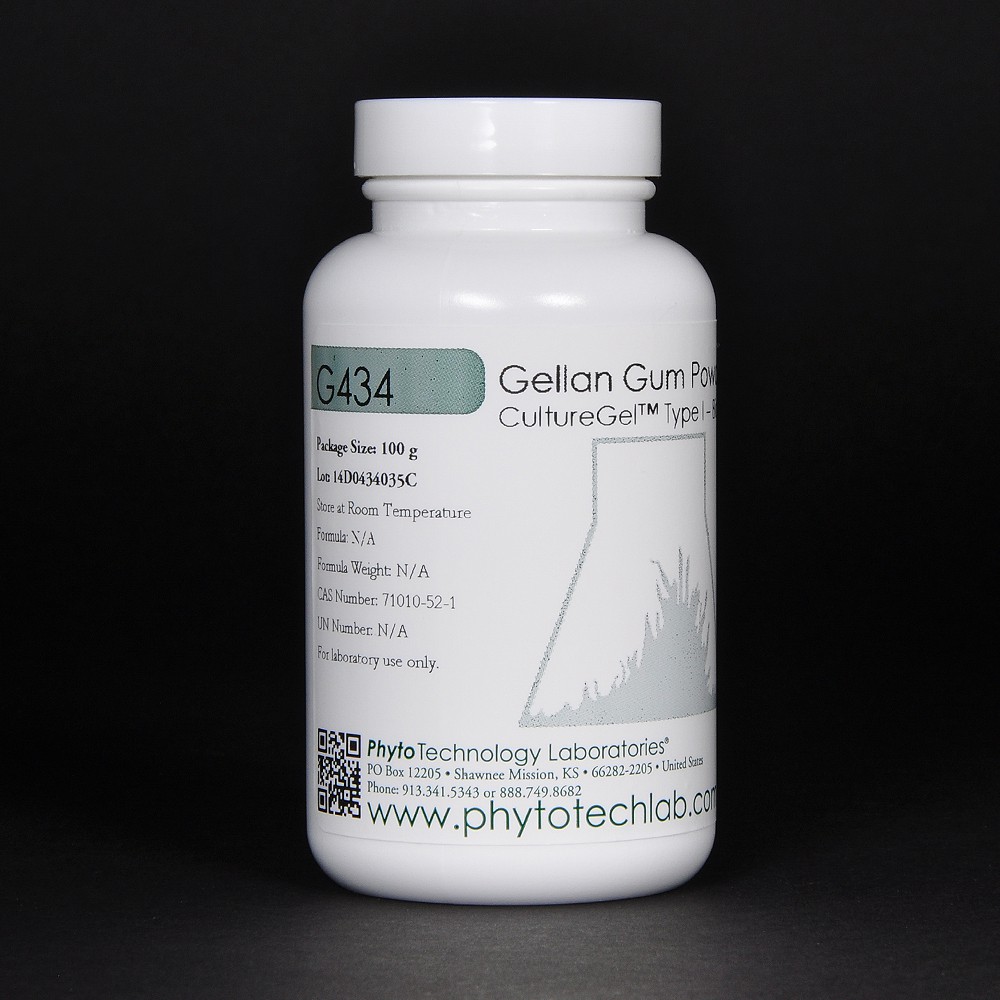 |
Life Technologies (India) Pvt Ltd. 306, Agarwal City Mall, opposite M2K Pitampura, Delhi-110034 (India) Tel # +91-11-4220-8000; 4220-8111; 4220-8222 Fax# +91-11-4220-8444, Mobile# +91-98105-21400, Toll Free# 1800-120-2434 Email# customerservice@lifetechindia.com |
Introduction:
Transparency (Clarity): = 80%.
Do not use with media containing high levels of calcium such as DKW and Quoirin & Lepoivre. Also if divalent cation (Ca2+, Mg2+) concentrations are below that of 1/2X MS (e.g. P668) you may need to increase the g/L to obtain free-standing gels. This gelling agent requires melting at 121°C. If your autoclave doesn't reach that temperature for 15-20 min the final gel may appear clumpy.
Synonyms: CulturegelT Type I; Biotech Grade

G434 Gellan Gum Powder
| Synonyms: | CultureGel™ Type I – BioTech Grade |
| CAS: | 71010-52-1 |
Properties
| Form: | Powder |
| Appearance: | White to Cream Powder |
| Application: | Plant Tissue Culture Gelling Agent |
| Solubility: | Partially Soluble in Cold Water; Soluble in Boiling Water |
| Typical Working Concentration: | 2 to 4 grams per liter |
| Storage Temp: | Room Temperature |
| Other Notes: | Transparency: Minimum 85% Gel Strength: Minimum 800 g/cm2 Gelrite® Equivalent Plant Tissue Culture Tested |
Application Notes
Gellan gum is produced by bacterial fermentation from a pure culture of Sphingomonas elodea (formerly Pseudomonas elodea). S. elodea is a well-characterized, gram-negative, non-pathogenic bacterium that secretes a high molecular weight polysaccharide gum. Gellan gum structure is composed of repeating tetrasaccharide (4 simple sugars) units, each consisting of two glucose (Glc) residues, one glucuronic acid (GlcA) residue, and one rhamnose (Rha) residue.2 Gellan gum will form a gel in the presence of mono- or divalent cations; the latter being more efficient, e.g., calcium, magnesium; however, gellan gum (Product No. G434) is not recommended for use with DKW (9.3 mM Ca++) or other media e.g., Quoirin & Lepoivre Basal Salt Mixture containing high calcium levels as they have shown to produce a soft and cloudy gel.
Hyperhydricity is often observed when culturing plant shoots on gellan gum. It is a condition that is characterized by translucent appearance that is associated with chlorophyll deficiency, poorly developed mesophyll layers and cell walls, and high water content3 ; however, this condition can be corrected by increasing gellan gum concentration or culturing on agar gels.
Gellan gum is typically used at 2 to 4 g/L. It is suspended in medium that is room temperature or colder. Attempting to suspend it in hot medium will usually result in an incomplete, lumpy suspension that will not melt and dissolve uniformly when autoclaved. It should be added to medium after all heat-stable supplements have been added.
PhytoTechnology Laboratories® also carries CP Kelco U.S. brand gellan gum called Gelzan, Product No. G3251.
Please Note: While PhytoTechnology Laboratories™ tests each lot of this product with two or more plant cell/ tissue culture lines, it is the sole responsibility of the purchaser to determine the appropriateness of this product for the specific plants that are being cultured and applications that are being used.
References
1. Merck 13, 4394
2. Jansson, PE and B Lindberg. 1983. Structural studies of gellan gum, an extracellular polysaccharide elaborated by Pseuomonas elodea. Carbohydr. Res. 124:135-139.
3. Kevers C, Franck T, Strasser RJ, Dommes J, Gasper T (2004). Hyperhydricity of micropropagated shoots: a typically stress induced change of physiological state. Plant Cell Tissue Organ Cult. 77: 181-191
